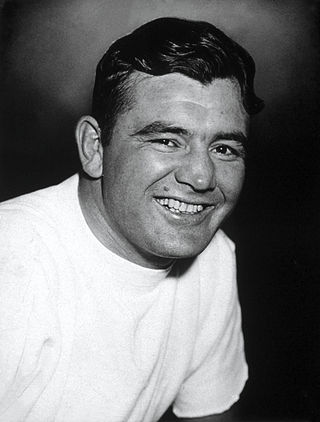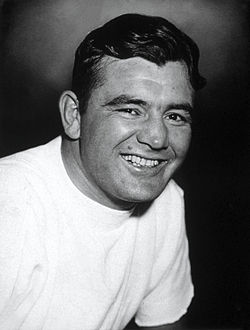Top Qs
Timeline
Chat
Perspective
James J. Braddock
American boxer (1905–1974) From Wikipedia, the free encyclopedia
Remove ads
James Walter Braddock (June 7, 1905 – November 29, 1974) was an American[3][4] boxer who was the world heavyweight champion from 1935 to 1937.[5]
Fighting under the name James J. Braddock (ostensibly to follow the pattern set by two prior world boxing champions, James J. Corbett and James J. Jeffries), Braddock was known for his spoiling, counterpunching style, powerful right hand, and his iron chin. He had lost several bouts due to chronic hand injuries and was forced to work on the docks and collect social assistance to feed his family during the Great Depression. He made a comeback, and in 1935 he fought Max Baer for the world heavyweight championship and won. For this unlikely feat he was given the nickname "Cinderella Man" by Damon Runyon.[6] Braddock was managed by Joe Gould.[1]
Remove ads
Early life
Braddock was born on June 7, 1905,[7] on West 48th Street in Manhattan's Hell's Kitchen neighborhood. He moved to North Bergen, New Jersey, at an early age. He was one of seven children[8] being raised by Irish immigrant parents Elizabeth O'Tool and Joseph Braddock.[9]
He stated his life's early ambition was to play college football for Knute Rockne at the University of Notre Dame, though this did not come to pass, as he remarked that he had "more brawn than brains".[10][11]
Remove ads
Boxing career
Summarize
Perspective
Braddock pursued boxing, fighting as a light heavyweight. His first fight in a ring occurred on November 27, 1923.[12] He turned pro at the age of 21. After three years, Braddock's record was 44–2–2 (.938), with 21 knockouts.
In 1928, Braddock pulled off a major upset by knocking out highly regarded Tuffy Griffiths. The following year he earned a chance to fight for the title, but he narrowly lost to Tommy Loughran in a 15-round decision. Braddock was greatly depressed by the loss and badly fractured his right hand in several places in the process.[3]
His next 33 fights were significantly less successful, with an 11–20–2 (.364) record. With his family in poverty during the Great Depression, Braddock was forced to give up boxing and work as a longshoreman. Due to frequent injuries to his right hand, Braddock compensated by using his left hand during his longshoreman work, and it gradually became stronger than his right.[13]
Braddock felt humiliated by having to accept government relief money, but he was inspired by the Catholic Worker Movement, a Christian social justice organization founded by Dorothy Day and Peter Maurin in 1933 to help the homeless and hungry. After his boxing comeback, Braddock returned the welfare money he had received and made frequent donations to various Catholic Worker Houses, and fed homeless people by inviting them to meals with his family.[14]
Max Baer fight
In 1934, Braddock was given a fight with the highly touted John "Corn" Griffin. Although Braddock was intended simply as a stepping stone in Griffin's career, he knocked out the "Ozark Cyclone" in the third round.[1] Braddock then fought John Henry Lewis, a future light heavyweight champion. He won in one of the most important fights of his career.[1] After defeating another highly regarded heavyweight contender, Art Lasky, whose nose he broke during the bout on March 22, 1935,[15] Braddock was given a title fight against the World Heavyweight Champion, Max Baer.[2][16]
Despite Braddock's recent impressive victories, he was hand-picked by Baer's handlers because he was seen as a little more than a journeyman fighter, an easy payday for the champion. Baer hardly trained for the bout; Braddock, on the other hand, trained hard. "I'm training for a fight, not a boxing contest or a clownin' contest or a dance," he said. "Whether it goes one round or three rounds or ten rounds, it will be a fight and a fight all the way. When you've been through what I've had to face in the last two years, a Max Baer or a Bengal tiger looks like a house pet. He might come at me with a cannon and a blackjack and he would still be a picnic compared to what I've had to face."[17]
The bout occurred on June 13, 1935, at Madison Square Garden Bowl, in Long Island City, New York. Baer, ever the showman, "brought gales of laughter from the crowd with his antics" the night he stepped between the ropes to meet Braddock. As Braddock "slipped the blue bathrobe from his pink back, he was the sentimental favorite of a Bowl crowd of 30,000, most of whom had bet their money 8-to-1 against him."[17] Baer "undoubtedly paid the penalty for underestimating his challenger beforehand and wasting too much time clowning."[18] During the fight, a dogged Braddock took a few heavy hits from the powerful younger champion (30 years versus 26 years for Baer), but Braddock kept coming, wearing down Baer, who seemed perplexed by Braddock's ability to take a punch. In the end, the judges gave Braddock the title with a unanimous decision, outpointing Baer 8 rounds to 6.[16][19] A 10-to-1 underdog, Braddock won the Heavyweight Championship of the World in what was called "the greatest fistic upset since the defeat of John L. Sullivan by Jim Corbett".[3][18]
Heavyweight champion; loss to Joe Louis
Braddock held the title of Heavyweight Champion from 1935 until 1937. His first title defense was to be against German Max Schmeling on June 3, 1937, in the Madison Square Garden Bowl. However, Braddock backed out of the bout in favor of a fight with Joe Louis in Chicago.[20] Braddock argued he would have received only a US$25,000 purse against Schmeling, compared to $250,000 against rising star Louis. There was also concern that if Schmeling won, the Nazi government would deny American fighters opportunities to fight for the title.[21] Finally, American commentators had expressed opposition to the fight in light of the connections between Schmeling and Adolf Hitler, with whom the German fighter had been associated after his earlier victory over Louis.[21][22] The New York State Athletic Commission fined Gould and Braddock $1,000 each for canceling the fight with Schmeling.[23]
In his only defense of the heavyweight title, Braddock lost to Louis in the 8th round by a knockout, the only one of his career.
Braddock and Louis saw each other frequently over the years, and the "Brown Bomber" always greeted him the same way: "Hello, Champ." As Jeremy Schaap wrote, "[Louis] fought eight world heavyweight champions, more than any other fighter ever, but he never called anyone but Jim Braddock 'champ.'"[24] On the other hand, shortly after winning the title, Louis was quoted as saying, "I don't want to be called champ until I whip Max Schmeling".[25] (Louis defeated Schmeling in 1938, part of his 12-year reign as Heavyweight champion, the longest championship reign in boxing history.)
Seven months after the Louis fight, Braddock had his next match with Tommy Farr and won in what turned out to be his last match.[26]
While the fight with Louis was the end of Braddock as a major boxing force, part of his contract for that bout was to gain a portion of Louis' earnings over the next decade, which proved very lucrative for him.[27]
Remove ads
Later life
Braddock enlisted in the U.S. Army in 1942 and became a first lieutenant. He served in the Pacific theater on the island of Saipan, where he trained enlisted men in hand-to-hand combat.[28][29]
Upon return, he opened a restaurant, called Braddock's Corner, located at 157 W. 49th Street, in New York City, which was managed by Joe Gould.[1] Braddock ultimately lost $15,000 on the restaurant venture.[30] He invested in a marine equipment surplus supplier, which also lost money.[30] Going back to manual labor, he helped construct the Verrazzano Narrows Bridge in the early 1960s.[30][31]
Personal life

Braddock married Mae Fox in 1930, and the couple had three children, James (Jay) Jr., Howard and Rosemarie.[32][29] He used the money from his fight with Joe Louis to buy a $14,000 home in North Bergen. [30] Through Rosemarie, Braddock's granddaughter is the actress Rosemarie DeWitt.[33]
Braddock was a member of the Fairview Teeko Club, New Jersey, where he was regarded as one of the strongest teekoists.[34]
Remove ads
Death and legacy

After his death in 1974 at the age of 69,[29] James J. Braddock was interred in the Mount Carmel Cemetery in Tenafly, New Jersey. He was inducted into the International Boxing Hall of Fame in 2001. James J. Braddock North Hudson County Park in North Bergen, New Jersey is named in his honor.[35] On September 16, 2008, a 10-foot, 1,500-pound bronze statue of Braddock was erected in the park named in his honor not far from where he lived and trained. The statue was created by internationally renowned sculptor Zenos Frudakis.[36]
The 2005 biographical film Cinderella Man tells Braddock's story. Directed by Ron Howard, it stars Russell Crowe as Braddock and Renée Zellweger as his wife, Mae.[37] The film had an estimated budget of $88 million and grossed $108.5 million worldwide.[38] Crowe's performance earned him a Golden Globe nomination for Best Actor. Paul Giamatti, playing Braddock's manager Joe Gould, was nominated for the Academy Award for Best Supporting Actor. The role of neighbor Sara Wilson was played by Rosemarie DeWitt, who is Braddock's real-life granddaughter. The film received mostly positive reviews.[39]
Remove ads
Professional boxing record
Summarize
Perspective
All information in this section is derived from BoxRec,[40] unless otherwise stated.
Official record
All newspaper decisions are officially regarded as “no decision” bouts and are not counted in the win/loss/draw column.
Unofficial record
Record with the inclusion of newspaper decisions in the win/loss/draw column.
Remove ads
Titles in boxing
Major world titles
- NYSAC heavyweight champion (200+ lbs)
- NBA (WBA) heavyweight champion (200+ lbs)
The Ring magazine titles
- The Ring heavyweight champion (200+ lbs)
Undisputed titles
See also
Notes
References
External links
Wikiwand - on
Seamless Wikipedia browsing. On steroids.
Remove ads

